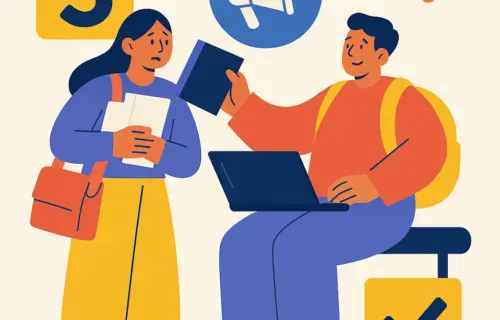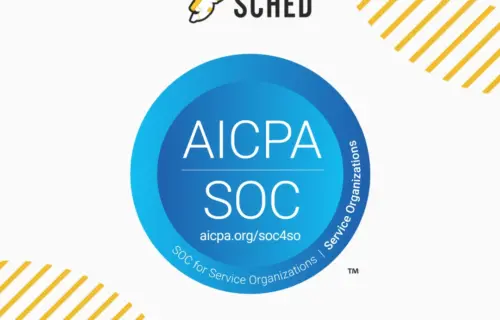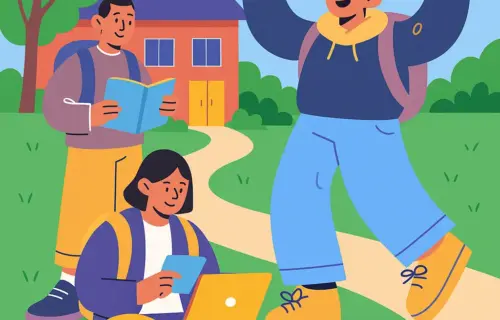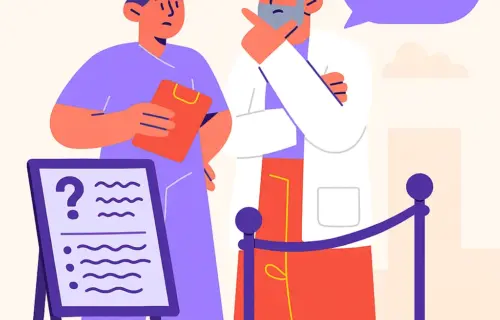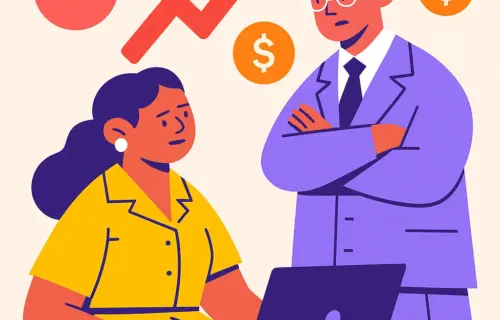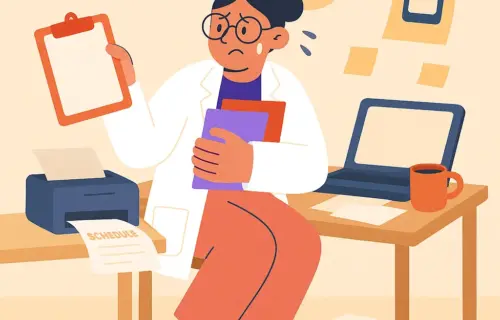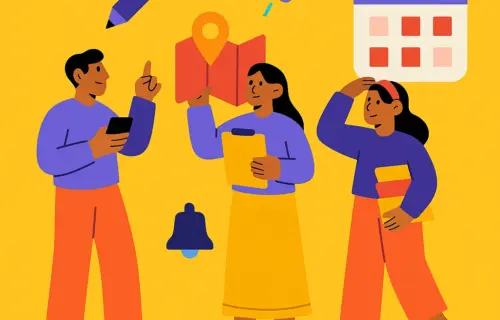Professional development works wonders when done right. On June 10, Sched sponsored a dynamic edWeb webinar: “Securing Student Success Through Transformative Teacher PD.” This live session brought together professional development (PD) experts from across the U.S. to share the strategies that truly move the needle for teachers and students alike.
Panelists included:
👤 Dr. Leanna Mullen, Student Data Coordinator, Egg Harbor Township School District (NJ)
👤 Fred Cochran, Coordinator for UDL Implementation, San Joaquin County Office of Education (CA)
👤 Tiffany Caouette, Assistant Executive Director, The Connecticut Association of Schools
👤 Joyce Whitby, CEO & Co-Founder, Innovations4Education (moderator)
If you missed the session, or just want a refresher, this post covers the top takeaways, with real-world examples, practical tips, and advice on transforming PD into a meaningful part of school culture.
Why We Need Personalized Professional Development in Our Schools
Table of contents
- 1 Why We Need Personalized Professional Development in Our Schools
- 2 How Do You Foster Teacher Collaboration Without Losing Structure
- 3 How Should PD Be Structured Throughout The School Year
- 4 How Can You Meet The Needs of Different Generations of School Teachers
- 5 Joy, Intention, and the Right Planning Tool: The Key to Effective PD
- 6 FAQs
- 6.1 1. What makes teacher professional development “transformative”?
- 6.2 2. Why is personalization important in professional development for teachers?
- 6.3 3. How can school leaders structure PD that actually works throughout the year?
- 6.4 4. What are the most effective PD formats for schools right now?
- 6.5 5. How do generational differences affect how teachers engage with PD?
- 6.6 6. What tools can help make professional development days easier to run?
K-12 schools need personalized professional development because meaningful growth happens when teachers feel seen, supported, and challenged at the right level. Teachers, like students, have unique learning needs. Throughout the webinar, the panelists agreed that personalization is non-negotiable if you want PD that sticks.
Fred emphasized using Universal Design for Learning (UDL) principles to ensure every teacher’s experience is purposeful and actionable.
“When I think about personalizing professional development, I think about the goals of UDL. I want to consider the adult as the learner in the room, and I want the training to be purposeful, reflective, resourceful, authentic, strategic, and action-oriented.”
Dr. Mullen shared how her district structured AI-focused PD for teachers at vastly different experience levels, from beginners to early adopters:
“Last year we had an AI day, so we made sure that we offered things from a very beginner level through an expert level and gave voice and choice to that. Like, you know what kind of PD you need, so have at it. Go wherever your learning path takes you.”
Tiffany discussed offering independent PD proposals to give teachers ownership over their learning paths and build trust.
“One-size-fits-all doesn’t work. We differentiate for students, so why not do the same for educators?”
How Do You Foster Teacher Collaboration Without Losing Structure
Creating space for teacher collaboration can feel messy, but the right format makes all the difference.
Vertical Articulation Sessions
Dr. Mullen’s district uses vertical articulation sessions (structured meetings between different grade levels), to help teachers connect across classrooms. They use guided templates to keep the conversation focused and actionable.
Cross-Grade PD Groups
Tiffany emphasized the importance of balance: her school organizes cross-grade PD groups where teachers choose their format (like book clubs or webinars), but still work toward shared goals with regular check-ins. It’s collaborative, but not chaotic.
Peer-Led UDL Coalitions
Fred encouraged low-pressure formats like walk-and-talks and peer-led UDL coalitions. These options allow teachers to share ideas in informal ways. It builds comfort and connection without overengineering the experience.
Together, these strategies promote psychological safety and meaningful dialogue. They help teachers learn from each other, not just from outside experts.
How Should PD Be Structured Throughout The School Year
The panel didn’t hesitate: August isn’t the time for deep professional learning.
“Teachers just want to get their rooms set up. Save the deep stuff for later,” says Dr. Mullen.
Instead, schools are turning to:
- Year-long PD calendars that balance full days with ongoing, bite-sized learning.
- PD pathways tied to district priorities like MTSS, SEL, or data-driven instruction.
- Google Classrooms or digital hubs where recordings, resources, and YouTube videos are shared for asynchronous access.
Tiffany noted that coherence and focus are critical. Her PD themes for the year include topics like ‘Student Discourse’ and ‘Small-Group Instruction,’ anchoring all PD events to a central vision.
5 Proven School PD Formats That Work
The panelists shared a range of formats to keep PD engaging and impactful:
✔️ Choice-based sessions and EdCamps.
✔️ Cross-district collaboration networks.
✔️ Peer-led workshops and teacher-led talks.
✔️ “Pod clubs” (instead of book clubs) for quicker, more accessible learning.
✔️ Micro-credential options for Gen Z educators.
Dr. Mullen emphasized the importance of tailoring PD formats to generational preferences, especially when building leadership capacity across your team.
“If you want to plan your succession pipeline, start investing in your millennials now.”
How Can You Meet The Needs of Different Generations of School Teachers
Professional development isn’t one-size-fits-all and that’s especially true across generations. Each group brings different expectations, preferences, and learning styles shaped by the era they grew up in.
The panelists broke down what this means in practice, and how you can thoughtfully design PD that resonates with everyone on your team.
👩🏫 Boomers
Often comfortable with more traditional approaches, boomers value face-to-face learning, structured sessions, clear objectives, and credible experts. As Dr. Mullen noted, “they still like that extended classroom time.” Fred also added that boomers are “cheat sheet” people. They want clarity, brevity, and direct access to what matters most.
🧑💼 Gen X
This group tends to be pragmatic and independent. Tiffany shared that Gen Xers prefer professional development that is relevant to their role and responsibilities, with a clear, practical application. “If I’m at [a training session] and I don’t see the practical application, I have a hard time connecting,” she said.
👩💻 Millennials
As the most highly educated generation, millennials actively value PD, and they want a say in it. According to Dr. Mullen, they see PD as an investment in their growth. “Letting them choose the PD they want to do or letting them host something shows you believe in what they have to offer,” she explained. And when they feel that support, they often become your most enthusiastic leaders and advocates.
📱 Gen Z
Still new to the workforce, Gen Z educators crave quick, mobile-friendly, gamified learning. Tiffany shared that her team is experimenting with “bite-sized boosts”, which are PD sessions that are 10-15 minutes long. This generation wants content that’s visual, accessible, and aligned to how they already consume information in daily life.
Joy, Intention, and the Right Planning Tool: The Key to Effective PD
“We need to nurture joy and play in adult learning, too. Not just in the classroom.”
Professional development should energize teachers, not drain them. That means creating space for laughter, curiosity, and meaningful connection. But it also means planning ahead, being intentional, and giving educators a personalized learning experience.
K-12 schools use Sched to run professional development that’s organized, accessible, and built around what teachers actually need. You can collect session proposals, manage schedules, track attendance, and gather feedback, all in one place.
If you want to bring more purpose (and a little joy) to your next PD day, learn more about how Sched supports K-12 professional development.
FAQs
1. What makes teacher professional development “transformative”?
Transformative PD goes beyond passive workshops or one-off sessions. It’s personalized, ongoing, and designed to directly impact classroom practice. When teachers feel supported and empowered to grow, student outcomes improve too.
2. Why is personalization important in professional development for teachers?
Personalized PD ensures that every teacher, whether brand new or highly experienced, can grow in ways that feel relevant and supportive. It also builds trust and ownership in the process.
3. How can school leaders structure PD that actually works throughout the year?
School leaders can structure effective year-round PD by starting with a year-long plan. Instead of relying on a single day in August, they should design a mix of full-day workshops, short sessions, and self-paced learning opportunities. Aligning all PD activities to a central theme or district priority helps maintain focus and build momentum over time.
4. What are the most effective PD formats for schools right now?
Some of the most impactful PD formats include:
- Choice-based EdCamps or sessions
- Peer-led workshops
- Cross-district collaboration groups
- Micro-credentials for skill-building
- “Pod clubs” for bite-sized content
These formats allow flexibility while keeping learning teacher-driven and relevant.
5. How do generational differences affect how teachers engage with PD?
Every generation learns differently:
Boomers prefer structure and face-to-face sessions.
Gen X looks for practical, directly applicable learning.
Millennials value choice, feedback, and leadership opportunities.
Gen Z craves short, mobile-friendly content and digital access.
Designing PD with these preferences in mind helps everyone stay engaged and supported.
6. What tools can help make professional development days easier to run?
Platforms like Sched are built specifically to help schools plan, manage, and track PD. With Sched, you can:
- Collect session proposals
- Create personalized schedules
- Track attendance in real-time
- Share materials in advance
- Gather post-session feedback right away
It’s everything you need to give teachers a smooth, personalized PD experience, all in one place.

